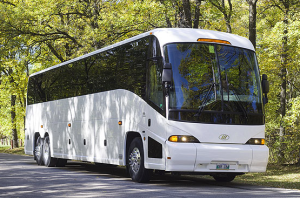Seat Belts will be required on tour buses
 Courtesy The Press Enterprise: Mark Muckenfuss and Janet Zimerman: After years of debate, industry heel dragging and government inaction, most tour bus companies are on track to outfit their vehicles with passenger seat belts in the next few years.
Courtesy The Press Enterprise: Mark Muckenfuss and Janet Zimerman: After years of debate, industry heel dragging and government inaction, most tour bus companies are on track to outfit their vehicles with passenger seat belts in the next few years.
The push has come in the wake of data showing that more than 60 percent of fatalities in tour bus accidents take place when the vehicle overturns. Without seat belts, passengers often are thrown from the bus, with deadly consequences.
Last Sunday’s tour bus crash on Highway 38 near Yucaipa has once again raised such safety concerns. The white bus owned by Scapadas Magicas, based in National City, was returning a Big Bear snow excursion when its brakes apparently failed, causing it to speed out of control, hit a car and smash head-on into a pickup truck, flipped on its side and slid before being knocked upright again. The bus had no seat belts.
The California Highway Patrol reported that at least five of the seven passengers who died were ejected. The driver of the pickup died a few days after the crash.
The Department of Transportation’s National Highway and Traffic Safety Administration said in a 2010 report that seat belts might reduce fatalities in rollover accidents by 77 percent. That assumes passengers would use the safety restraints. Some tour bus operators say that even when buses are equipped with seat belts, only about 10 percent of passengers, or fewer, use them.
New seat belt regulations this year are expected to require seat belts in tour buses, and many tour companies, knowing the regulations are imminent, already have begun switching to buses outfitted with the restraints.
The numbers from the Yucaipa crash add to a grim total in recent years.
Data from the traffic safety agency show that between 2003 and 2009, 133 people were killed in motor coach accidents. But a 2011 report by USA Today said that because of the way such accidents are recorded, the federal agency had undercounted by 24 percent. It said the actual total was 165.
As far back as 1999, tour bus safety has been a priority for the National Transportation Safety Board, which oversees the traffic safety agency. That year, the NTSB recommended that the agency study the issue.
“What we said was to develop standards to account for frontal, side and rear impact collisions as well as rollovers,” NTSB spokesman Keith Holloway said.
 Researchers were asked to come up with recommendations for the best way, whether it was seat belts or some other safety system, to protect passengers.
Researchers were asked to come up with recommendations for the best way, whether it was seat belts or some other safety system, to protect passengers.
“The recommendation is still open,” Holloway said, meaning the traffic safety agency failed to follow through. “The response we’ve gotten from them is unacceptable.”
In a 2010 statement, Transportation Secretary Ray LaHood said, “Seat belts save lives, and putting them in motor coaches just makes sense.”
The traffic safety agency has issued several reports in recent years as well as two action plans, the second of which was published last year. That latest action plan, issued in August 2010, referred to a proposed rule requiring lap and shoulder belts for every seat on motor coaches. It said the agency had received “over 130 comments” on the proposal and was still evaluating them.
A highway funding bill — the Moving Ahead for Progress in the 21st Century Act — that was signed into law last July has a provision that requires the transportation secretary to establish regulations requiring seatbelts on motor coaches by the end of this year.
Many companies are way ahead of the government.
Maureen Richmond is a spokeswoman for Greyhound, the nation’s largest interstate bus company. She said the company already has seatbelts in 75 percent of its motor coaches.
“We started to install them in 2008,” Richmond said. “We took a look at what our customers were asking for.”
Most of them were calling for more entertainment and Internet features, she said. “But there was also a request for seat belts.”
She said each new bus that replaces an old one in the Greyhound fleet will have lap and shoulder belts. She was unsure how much longer it would take before all of the company’s buses are equipped.
Other company owners said they believe a seatbelt requirement is inevitable, and they have already begun making the shift.
At H & L Charter in Ontario, president Elaine Fickett said six of her 13 buses are outfitted with seat belts.
“I believe it is going to be mandated in the future,” Fickett said.
She has run the company since 1989, and her own thinking on the issue has changed in recent years.
“I do believe that they are more necessary than I believed previously,” she said.
She’s not convinced they will reduce injuries in crashes. But she thinks they may reduce the number of ejections.
“Hopefully it’s going to keep them in the bus,” she said.
But that’s only if passengers use them.
When she travels on her seat belt-equipped buses, she said, not many riders take advantage of the safety feature, even though they are encouraged to do so before the bus hits the road.
“The percent that I see do it are relatively few,” Fickett said. “If you had a group of 40, maybe a couple of people.”
The story is different with school buses. In 2005, California became the first state to require lap and shoulder belts on new school buses.
Since 1977, the federal government has required school buses to use “compartmentalization” – high, padded seat backs designed to absorb impact in a crash. But the system didn’t provide protecting in rollovers or prevent children from being ejected.
All of the 215 buses that Student Transportation of America provides for Riverside and Val Verde unified school districts are equipped with seat belts, said Mark Worley, the company’s safety director.
Most children comply with the rule to buckle up, he said.
“In our society today, seat belts are required to be worn in cars. I think most kids are growing up with that and readily accepting of it,” he said.
School bus drivers do a walk-through before each trip to make sure students are buckled in, said Marta Nelson, transportation manager for Riverside Unified, which buses more than 5,000 children per day. But it can be hard to keep track, she said.
Drivers can issue citations to students who don’t wear a seat belt or who violate other rules. Repeat offenders can be suspended from the bus, she said.
Studies from pilot programs in the six states where school bus seat belts are required – and students are required to wear them – showed that at least 75 percent of elementary students buckle up; among middle and high school students, compliance dropped to 50 percent of less, according to the National School Transportation Association.
In New York, the only state that requires seat belts but does not insist that students use them, the rate is close to zero at all grade levels, the association said.
Getting seat belts on a new bus costs $8,500 to $13,000.
Data showing the impact of the new belts was not available.
A recent study by the traffic safety agency “concluded that requiring lap belts on large, new school buses would appear to have little, if any, benefit in reducing serious-to-fatal injuries in severe frontal crashes. Assuming 100 percent usage and no misuse, lap/shoulder belts could save one life a year.”
In contrast, a 2004 report by three private safety groups in Australia noted that since a mandatory seat belt law had been enacted 10 years earlier, “there have been several serious bus crashes, but no seat belt wearing occupant has been reported as receiving fatal or disabling injuries in any of these crashes.”
Dan Ronan, spokesman for the American Bus Association, said despite the ongoing debate, seat belts will be a standard feature on buses in the near future. They are an option on almost any new bus, and buyers are requesting them.
“I can’t think of anyone who I’ve heard of who has bought a new coach in the last 18 months or a year that hasn’t put in seat belts,” Ronan said.
The only question is how soon the restraints will be required.
“The manufacturers are ready, and the companies are ready,” Ronan said. “We’re waiting for the Department of Transportation to make a final ruling.”
SEAT BELT LAWS ON BUSES
PASSENGER COACHES: No federal or state law requires seat belts on charter, city or shuttle buses. The National Highway Traffic Safety Administration has proposed seat belts on all new buses to prevent deaths, primarily in rollover accidents.
SCHOOL BUSES: No federal law requires seat belts on large school buses, but six states, including California, mandate them. The California law requires three-point seat belts on buses that carry more than 16 passengers and were manufactured on and after July 1, 2005, and on smaller school buses manufactured on and after July 1, 2004. Students are required to use seat belts; drivers can issue citations and bus suspensions to children who remove them, though no one can be prosecuted for non-use
Category: General Update, Management









